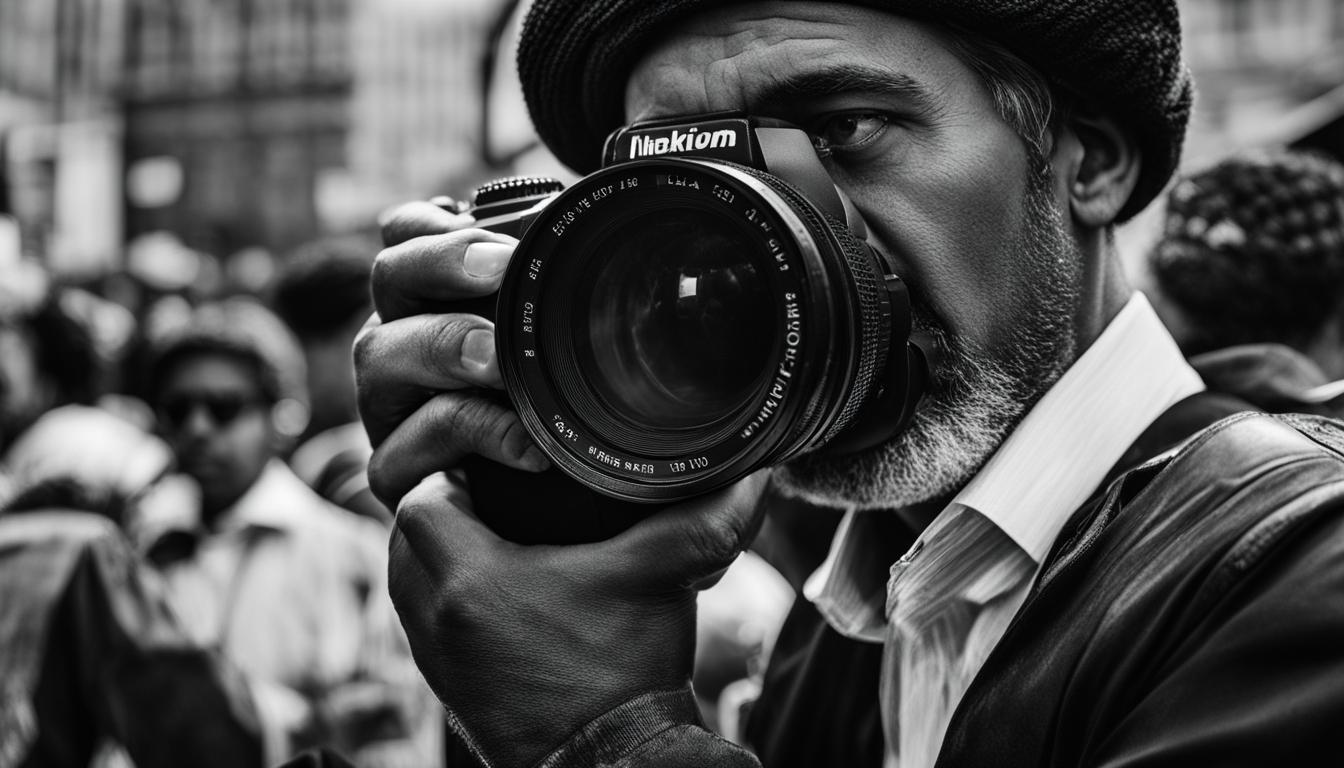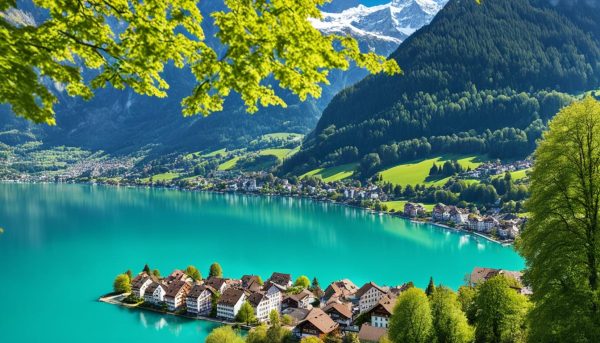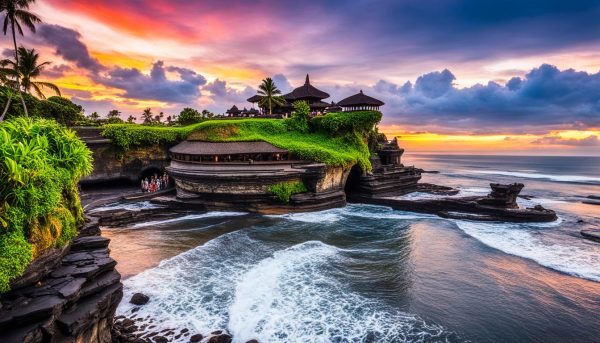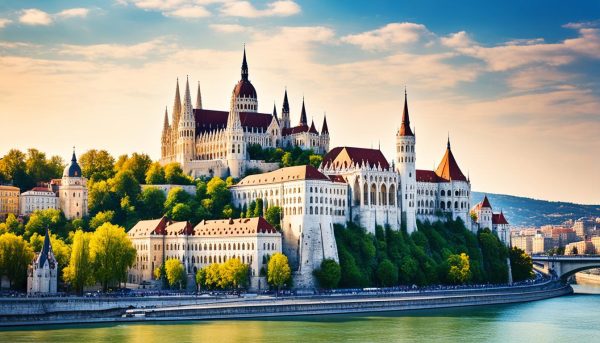In the world of journalism, storytelling with pictures holds immense value. Photographs have the power to capture a moment, convey emotions, and tell a narrative that words cannot always express. Images are integral to journalism, and their role has only grown in importance as technology has advanced.
At the heart of photojournalism lies the ability to capture the moment, to freeze time and communicate a story. Photographs convey an undeniable authenticity that words sometimes lack. A photograph can be visceral, raw, and immediate, bringing the viewer closer to the story than any written report could.
As photography has evolved, so too has its role in journalism. From the early days of black and white prints to today’s digital cameras, the tools of photojournalism have changed, but its impact remains. In this article, we will examine the crucial role that photography plays in journalism, its evolution, and the techniques used to create powerful images.
Key Takeaways:
- Photographs play a crucial role in conveying narratives and capturing significant moments in news reporting.
- The evolution of photography and its impact on photojournalism have been profound.
- Visual storytelling has the power to convey emotions and communicate complex narratives more effectively than words alone.
- Photojournalists must navigate ethical considerations and strive for objectivity in their work.
- The techniques used by photojournalists to capture significant moments are essential to the impact of their work.
The Evolution of Photojournalism
Photojournalism has come a long way since its early days. In the mid-1800s, the first cameras were invented, and photographers quickly began to document the world around them. However, it wasn’t until the 1920s and 1930s that photojournalism began to emerge as an essential form of journalism.
One of the most significant changes in photojournalism came with the invention of the 35mm camera in the 1930s. This smaller, more portable camera allowed photojournalists to capture images from any location, making it easier to cover events as they happened.
The next significant change came with the introduction of color photography in the 1940s and 1950s. This new technology allowed for more visually engaging and impactful images, and led to the rise of photojournalism as a respected art form.
The Vietnam War
The Vietnam War was a turning point for photojournalism. The images captured by photographers like Eddie Adams and Nick Ut had a significant impact on public opinion and played a significant role in bringing the war to an end. This stark, unflinching portrayal of the horrors of war cemented the role of photojournalism in society and proved its power to influence public perception.
The advent of digital photography in the 1980s and 1990s brought about another revolution in photojournalism. This new technology allowed for faster, more efficient image capture and editing, and made it easier than ever to transmit images from remote locations. Today, almost all photojournalism is captured digitally, and the speed and convenience of this technology have transformed the field.
Overall, the evolution of photojournalism has been shaped by technological advancements, changing societal attitudes, and the shifting role of the media in society. As we look to the future, it’s clear that photojournalism will continue to evolve and adapt to meet the needs of a changing world.
The Power of Visual Storytelling
Visual storytelling has become an indispensable part of journalism. In today’s fast-paced world, images have the power to convey emotions, capture attention, and convey complex narratives more effectively than words alone. This section will explore the impact of images in journalism and how they help create compelling stories that resonate with audiences.
The Impact of Images
Images have a profound impact on journalism. They provide a visual context that complements written articles, making them more engaging and memorable. A study by Forbes found that articles with images received 94% more views than those without. Visual storytelling also improves comprehension and retention. According to one study, people remember 65% of information when paired with relevant images compared to just 10% without images.
Images also help to create an emotional connection with the audience. They can evoke empathy, inspire action, and provoke thought. For example, the iconic photograph of the Syrian boy, Alan Kurdi, washed up on a Turkish beach in 2015, provoked international outrage and forced a global conversation about the refugee crisis. Such images have the power to transform public perception and drive social change.
The Art of Visual Storytelling
Visual storytelling is both an art and a science. It requires creative vision, technical skill, and journalistic sensibility. A compelling photograph must not only be visually arresting, but it must also tell a story. Each image must be carefully crafted to communicate a message or convey an emotion. As photojournalist David Hume Kennerly puts it, “A good photograph is one that communicates a fact, touches the heart, and leaves the viewer a changed person for having seen it.”
The composition, lighting, timing, and other technical aspects of a photograph also play a crucial role in visual storytelling. Photojournalists must be skilled in using these elements to capture a moment and create a sense of place, time, and emotion. The use of color, contrast, and light can create mood, depth, and texture, adding layers of meaning to an image.
The Role of Ethics in Visual Storytelling
As with any form of journalism, visual storytelling must adhere to ethical standards. Photojournalists must maintain objectivity, truthfulness, and integrity in their work. They must not manipulate images in a way that changes the original context or misleads the audience. Any editing or modification must be done transparently and with the purpose of enhancing the image’s clarity or accuracy.
Additionally, photojournalists must also consider the impact of their images on the subjects and communities in the frame. They must be respectful of cultural differences and sensitive to the potential consequences of their work. As photojournalist Lynsey Addario notes, “We are responsible for what we capture with our cameras and how we shape what the world sees.”
Images have the power to convey emotions, capture attention, and convey complex narratives more effectively than words alone. Visual storytelling is an essential component of contemporary journalism, requiring both creative vision and technical skill. Photojournalists must adhere to ethical standards, maintaining objectivity, truthfulness, and integrity in their work while considering the impact of their images on the subjects and communities they represent.
Photojournalism Ethics and Objectivity
Photojournalism is a branch of journalism that emphasizes the use of photographs to tell a news story. However, just like in traditional journalism, photojournalism also requires adherence to ethical standards and principles of objectivity.
One of the essential principles of photojournalism ethics is to maintain the integrity of the photograph. Photographs should not be manipulated or altered in any way that changes their original content or context. Any editing or post-processing should aim to improve the image’s clarity or quality rather than change its meaning.
Another critical ethical consideration in photojournalism is objectivity. Photojournalists should strive to be impartial and present a fair and accurate representation of a situation or event. They should not allow their personal biases or beliefs to influence their choice of subject matter or the way they capture and present the images.
To ensure objectivity, photojournalists should strive to maintain distance from the subjects they are photographing. They should not intervene or alter the situation to capture a specific shot. Additionally, photojournalists should avoid using clichéd or sensationalized images that distort the actual story’s representation.
In some situations, photojournalists may face ethical dilemmas, such as whether to take photographs of sensitive or graphic events. In such cases, they must balance the public’s right to know with the subjects’ privacy and dignity.
“Good photojournalism requires both discipline and passion. Discipline to resist the temptation to manipulate images to better serve a personal or institutional agenda, and passion to capture the human drama that lies behind the news.”
Photojournalism ethics and objectivity are crucial to maintain the credibility and trust of the audience. While photographs have the power to elicit strong emotions in viewers, it is vital that photojournalists present a fair and accurate representation of events without manipulating the audience’s emotions.
Capturing the Moment: Photojournalism Techniques
Capturing the moment is a crucial aspect of photojournalism. It requires not only technical skills but also an eye for detail and the ability to anticipate significant moments. Here are some of the essential photojournalism techniques:
| Technique | Explanation |
|---|---|
| Composition | The way elements are arranged within a frame can significantly impact the effectiveness of a photograph. Photojournalists must understand how to use the rule of thirds, leading lines, and other compositional techniques to create visually interesting and compelling images. |
| Lighting | Lighting can make or break a photograph. Understanding how to use natural light or artificial light sources to create mood and capture detail is essential. Photojournalists must also know how to work under challenging lighting conditions, such as low light or backlit situations. |
| Timing | Knowing when to press the shutter button is crucial in photojournalism. Anticipating the action and capturing the decisive moment is what sets great photojournalists apart. |
| Lens Choice | The choice of lens can significantly impact the final image. Understanding how different focal lengths affect perspective and depth of field is essential. |
Another critical technique in photojournalism is the ability to capture candid moments. Candid shots can offer genuine insights into a subject and tell a more authentic story. However, photojournalists must know when it’s appropriate to take candid shots and when to ask for permission.
Finally, photojournalists must be able to work quickly and efficiently. They often have limited time to capture events and must be ready to adapt to changing circumstances.
The Role of Photo Editing in Journalism
Photo editing plays a critical role in journalism, ensuring that images used in news stories are not only visually appealing, but also accurate and informative. Through photo editing, photographers and editors can select the most relevant images to support the story’s narrative, crop and enhance photographs for better composition, and adjust colors and lighting to improve visibility and clarity.
Additionally, photo editing allows for the removal of distracting elements in an image or the addition of text or graphics to provide additional context. In some cases, photo editing can even help to obscure identifying details of individuals featured in an image to protect their privacy.
However, photo editing also presents ethical considerations for journalists. While minor adjustments to images are generally accepted in the field, major alterations that change the meaning or context of a photograph are considered unethical. Journalistic integrity relies on honest and truthful reporting, and images must accurately reflect the events they depict.
Despite these challenges, photo editing remains an integral part of journalism, allowing for effective visual storytelling and enhancing the impact of news photographs.
“Photojournalism without editing is stillborn. It is the photographer’s responsibility to use photography, editing, and captioning to tell a story.”
Photojournalism and Social Media
Social media has had a profound impact on the field of photojournalism. Platforms like Instagram, Twitter, and Facebook have transformed the way news photographs are shared, consumed, and interpreted by the audience.
The rise of social media has made it easier for photojournalists to connect with people from all over the world, share their work, and build a following. It has also given them access to a vast array of user-generated content, which can be used to supplement their own reporting.
However, the use of social media in photojournalism has also raised ethical concerns. As news organizations increasingly rely on user-generated content, the verification of these images becomes more challenging. They must ensure the accuracy and authenticity of the images they use to avoid misleading the public.
Social media has also led to a proliferation of fake news, which can undermine the credibility of photojournalism. It is essential that photojournalists and news organizations take steps to combat this problem and ensure they maintain the public’s trust.
Despite these challenges, social media has opened up new opportunities for photojournalists to tell stories and share their work. By leveraging these platforms, they can reach a broader audience and connect with people in ways that were not possible before.
“Social media has transformed the way news photographs are shared, consumed, and interpreted by the audience.”
Iconic Photographs in Journalism
The power of a single image to capture a significant moment, tell a story, and evoke emotion is undeniable. In journalism, photographs have played a critical role in shaping public perception and influencing historical events. Here are some of the most iconic photographs in the history of journalism:
| Photograph | Publication | Year |
|---|---|---|
| Life Magazine | 1945 | |
|
https://www.youtube.com/watch?v=AyL6F6ruAzc |
The New York Times | 1989 |
| The New York Times | 2001 |
The photograph of the aftermath of the atomic bombing of Hiroshima, published in Life Magazine in 1945, is one of the most iconic images in the history of photojournalism. Taken by Joe O’Donnell, the photograph captures the devastation and horror of the attack, and serves as a stark reminder of the devastating human toll of war.
The image of “Tank Man,” taken during the 1989 Tiananmen Square protests by photographer Jeff Widener and published in The New York Times, has become a symbol of peaceful resistance and defiance in the face of oppression. The photograph shows an unidentified man standing in front of a line of tanks, blocking their path and refusing to back down.
The photograph of “The Falling Man,” taken by Richard Drew and published in The New York Times in the aftermath of the 9/11 terrorist attacks, has been the subject of much controversy and debate. The image shows a man falling from the North Tower of the World Trade Center, and has been interpreted in various ways, from a symbol of tragedy and loss to a representation of the human capacity for survival.
These photographs, and countless others like them, have the power to transcend words and convey complex emotions and ideas in a single image. They remind us of the importance of photography in journalism, and the crucial role that photojournalists play in documenting the world around us.
Photojournalism and Advocacy
Photojournalism has long been a powerful tool for advocating social and political causes. Photographs have the ability to capture emotions, tell stories, and influence public opinion, making them a crucial component in social activism.
One example of this is the iconic photograph, “Migrant Mother” by Dorothea Lange. The image, taken during the Great Depression, depicts a mother and her children who were struggling to make ends meet. The stark reality of the photo helped to bring attention to the plight of migrant farm workers and raised awareness of the need for government assistance.
Another example is the work of Kevin Carter, who photographed the famine in Sudan in the 1990s. His heart-wrenching image of a starving child being stalked by a vulture ultimately led to increased aid to the region and raised international awareness of the severity of the crisis.
Photojournalists today continue to use their photographs to advocate for social change. Images of police brutality, human rights abuses, and environmental disasters have all helped to spark public outrage and push for reforms.
“The power of images is that they can bypass language and cultural barriers, and speak directly to our emotions.”
However, photojournalism and advocacy also raise ethical questions. Should photojournalists remain objective in their reporting or take an active role in advocating for a cause? Can a photograph be both truthful and persuasive?
Despite these challenges, photojournalism remains an essential tool in advocating for social justice. By capturing the realities of the world around us, photographs have the power to inspire empathy, drive action, and effect change.
The Future of Photojournalism
The field of photojournalism has undergone significant changes in recent years, thanks to advancements in technology and the emergence of new trends. As we look to the future, it’s clear that there are several exciting developments on the horizon.
One emerging trend in photojournalism is the use of drone photography. Drones offer a unique perspective on news events, allowing photographers to capture images from angles that were previously impossible. This technology has already been used to capture stunning aerial shots of natural disasters, political protests, and other newsworthy events.
Another trend that is likely to shape the future of photojournalism is virtual reality. As this technology becomes more widespread and accessible, it’s expected that news organizations will begin to incorporate it into their storytelling. This could mean immersive VR experiences that transport viewers to the heart of a news event, allowing them to experience it as if they were there.
Citizen journalism is another trend that is poised to have a significant impact on photojournalism in the coming years. With the rise of social media, anyone with a smartphone can take and share photos of news events as they happen. While this presents challenges in terms of quality and accuracy, it also provides a valuable source of real-time reporting that can supplement traditional news coverage.
As we consider these emerging trends and the future of photojournalism, it’s clear that the field will continue to evolve and change in exciting ways. From drones and VR to citizen journalism and beyond, the opportunities for visual storytelling are endless.
The Collaborative Nature of Photography and Journalism
Photography and journalism share a symbiotic relationship, with each field complementing the other’s strengths to tell compelling stories. While journalism provides the context and information, photography adds a visual dimension that can evoke emotion and convey meaning in a way that words alone cannot. This collaboration has led to some of the most iconic images in history, from Dorothea Lange’s “Migrant Mother” to Eddie Adams’ “Saigon Execution.”
The partnership between photographers and journalists requires a deep mutual respect and understanding of each other’s roles. A photographer’s ability to capture moments and convey emotion through their images is essential for effective storytelling, but it is the journalist’s job to ensure accuracy and report the facts truthfully. Together, they can create a powerful narrative that informs and moves the audience.
How Photographers and Journalists Collaborate
In order to create impactful stories, photographers and journalists often collaborate throughout the reporting process. They work together to determine the story angle, decide on how to best represent it visually, and plan the logistics of capturing the necessary footage or images. The result is a cohesive story that is both informative and visually engaging.
During the actual shooting or reporting process, photographers and journalists must navigate the ethical considerations of photojournalism. This includes obtaining necessary permissions and releases, protecting the privacy of subjects, and ensuring that images are not manipulated to misrepresent the truth. By working together, photographers and journalists can maintain the integrity of the story and uphold journalistic values.
The Future of Photography and Journalism Collaboration
The technological advancements of recent years have revolutionized the way photography and journalism collaborate. News organizations are now using drones to capture aerial images of breaking news events, and virtual reality technology allows viewers to immerse themselves in a story in a way that was once impossible. Social media platforms have also made it easier for journalists and photographers to share their work and connect with audiences around the world.
As technology continues to evolve, the collaboration between photography and journalism is likely to become even more seamless and impactful. By working together to tell powerful stories, photographers and journalists can inform, inspire, and move the world to action.
Conclusion
Throughout this article, we have explored the crucial role that photography plays in journalism. As we have seen, storytelling with pictures is a powerful communication tool that can capture attention, convey emotions, and communicate complex narratives more effectively than words alone.
We examined the evolution of photojournalism, from its early days in black and white to the digital age, where technological advancements are transforming the field. We also discussed the ethical considerations and challenges faced by photojournalists, the techniques used to capture significant moments, and the role of photo editing in journalism.
Social media has also had a significant impact on photojournalism, transforming the way news photographs are shared, consumed, and interpreted by the audience. We highlighted iconic photographs that have influenced historical events and the role of photojournalism in advocacy for social and political causes.
Looking ahead, emerging trends such as drone photography, virtual reality, and citizen journalism may shape the field’s future. The collaborative relationship between photography and journalism is essential, where mutual understanding, respect, and teamwork are key factors in telling compelling stories.
In conclusion, photography is a vital part of journalism, and its significance cannot be underestimated. The power of visual storytelling has the potential to create impact and lasting impressions on readers, and photojournalists play a crucial role in capturing and conveying significant events and stories to the public.
FAQ
What is the role of photography in journalism?
Photography plays a crucial role in journalism by capturing significant moments, conveying narratives, and adding visual impact to news stories.
How has photojournalism evolved over the years?
Photojournalism has evolved from black and white images to digital photography, with advancements in technology shaping the way photographs are used in journalism.
What is the power of visual storytelling in journalism?
Visual storytelling in journalism has the ability to communicate emotions, capture attention, and convey complex narratives more effectively than words alone.
What are the ethics and objectivity considerations in photojournalism?
Photojournalists face ethical considerations and challenges related to objectivity and truthfulness. They play a crucial role in shaping public perception through their photographs.
What techniques are used in photojournalism to capture significant moments?
Photojournalists use techniques such as composition, lighting, timing, and other technical aspects to capture impactful and memorable photographs.
How does photo editing contribute to journalism?
Photo editing plays a vital role in journalism by enhancing visual appeal and ensuring accuracy in selecting and presenting images that support news stories.
What is the impact of social media on photojournalism?
Social media platforms like Instagram and Twitter have transformed the way news photographs are shared, consumed, and interpreted by the audience.
What are some iconic photographs in journalism?
Iconic photographs have had a significant impact on journalism, shaping public perception and influencing historical events. We will explore the stories behind these images.
How does photojournalism advocate for social and political causes?
Photojournalism advocates for social and political causes by using photographs to raise awareness, provoke change, and give a voice to marginalized communities.
What does the future hold for photojournalism?
The future of photojournalism may involve emerging trends such as drone photography, virtual reality, and citizen journalism, which could shape the field in significant ways.
How do photography and journalism collaborate?
Photography and journalism have a collaborative relationship, with photographers and journalists working together to tell compelling stories and emphasizing mutual understanding and respect.






